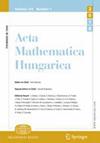关于Rankin-Selberg l -函数系数的渐近性
IF 0.6
3区 数学
Q3 MATHEMATICS
引用次数: 0
摘要
设f和g是满模群\(SL(2,\mathbb{Z})\)的两个不同的全纯顶点形式或质量顶点形式。我们对Rankin-Selberg l -函数的系数感兴趣,并建立$$\begin{aligned}\sum_{n\leq x} \lambda_{{\rm sym}^if\times {\rm sym}^jg}(n),\quad\sum_{n\leq x}\lambda_f(n^i)\lambda_g(n^j),\\sum_{n\leq x} |\lambda_{{\rm sym}^if\times {\rm sym}^jg}(n)|, \quad \sum_{n\leq x}|\lambda_f(n^i)\lambda_g(n^j)|, \end{aligned}$$和$$\sum _{n\leq x} \max \bigl\{|\lambda_{{\rm sym}^if\times {\rm sym}^jg}(n)|^{2\varphi}, |\lambda_{{\rm sym}^if\times {\rm sym}^jg}(n+h)|^{2\varphi} \bigr\}, $$的一些边界,其中\(\varphi>0\)和h是一个固定的正整数。本文章由计算机程序翻译,如有差异,请以英文原文为准。
On the asymptotics of coefficients of Rankin–Selberg L-functions
Let f and g be two different holomorphic cusp froms or Maass cusp forms for the full modular group \(SL(2,\mathbb{Z})\). We are interested in coefficients of Rankin–Selberg L-functions, and establish some bounds for
$$\begin{aligned}\sum_{n\leq x} \lambda_{{\rm sym}^if\times {\rm sym}^jg}(n),\quad
\sum_{n\leq x}\lambda_f(n^i)\lambda_g(n^j),
\\sum_{n\leq x} |\lambda_{{\rm sym}^if\times {\rm sym}^jg}(n)|, \quad
\sum_{n\leq x}|\lambda_f(n^i)\lambda_g(n^j)|,
\end{aligned}$$
and
$$\sum _{n\leq x} \max \bigl\{|\lambda_{{\rm sym}^if\times {\rm sym}^jg}(n)|^{2\varphi}, |\lambda_{{\rm sym}^if\times {\rm sym}^jg}(n+h)|^{2\varphi} \bigr\}, $$
where \(\varphi>0\) and h is a fixed positive integer.
求助全文
通过发布文献求助,成功后即可免费获取论文全文。
去求助
来源期刊
CiteScore
1.50
自引率
11.10%
发文量
77
审稿时长
4-8 weeks
期刊介绍:
Acta Mathematica Hungarica is devoted to publishing research articles of top quality in all areas of pure and applied mathematics as well as in theoretical computer science. The journal is published yearly in three volumes (two issues per volume, in total 6 issues) in both print and electronic formats. Acta Mathematica Hungarica (formerly Acta Mathematica Academiae Scientiarum Hungaricae) was founded in 1950 by the Hungarian Academy of Sciences.

 求助内容:
求助内容: 应助结果提醒方式:
应助结果提醒方式:


